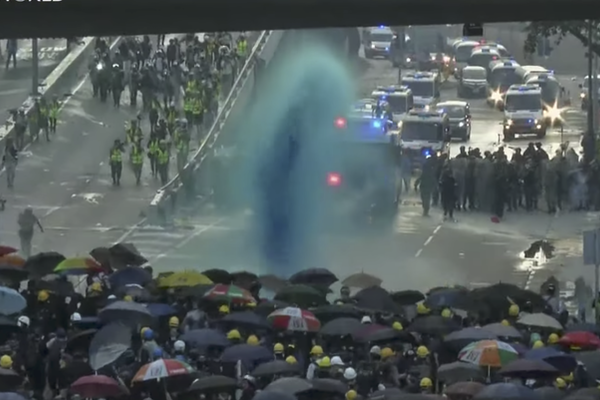The Long History of Activism Preceding The Hong Kong Democracy Protests

All this summer, Hong Kong has been consumed by protests and there’s no end in sight. The protests started in full force back in June, mainly as a backlash against an extradition bill that would have allowed the Hong Kong government to send anyone to China for any so-called wrong-doing. Along the way, the protestors have become enraged at the police for repeatedly firing tear gas, rubber bullets, and bean bags, as well as beating people with batons. This unrest seems so unlike Hong Kong, but in fact has been brewing for decades.
The unrest is a continuation from the 2014 Umbrella Movement, in which people stood up against changes to Hong Kong’s Basic Law, or mini-constitution, which was supposed to guarantee the territory 50 years of political autonomy after Britain handed Hong Kong back to China in 1997. The 2014 protests spanned two and a half months and paralyzed the main financial district as students set up tent cities in the middle of a major thoroughfare. Those protestors dispersed after the government cleared the streets and threatened to arrest anyone who stayed behind. The government also arrested and imprisoned the main leaders of the Umbrella Movement, including two professors at Hong Kong’s most prestigious universities, as well as teenaged student leader, Joshua Wong.
But the problems in Hong Kong stem from way before 2014. Back in 1922, Hong Kong Chinese seamen demanded 40% higher wages to bring them closer pay equity with their non-Chinese counterparts. The shipping companies—run mainly by the British—refused to pay them more, so the Chinese seamen went on strike. The Hong Kong government declared the strike illegal, but the strike still disrupted life in Hong Kong because goods to the colony were all but cut off by the strike. So 52 days into the strike, the Hong Kong government negotiated with the Seamen’s Union and the two parties agreed to a raise between 15-30%.
Another sea-related demonstration took place in 1966 when the Hong Kong government proposed an increase in fares for the Star Ferry, a means of transportation used by workers and professionals alike. What started out as a demonstration against the increased fares turned into a riot against the colonial government. The protestors felt that the government was out of touch with the people and the police force was too corrupt. Police used tear gas and batons on the protestors, leaving one dead and four injured. Over 200 protestors were arrested and imprisoned. The following year, leftist riots broke out against the colonial government, resulting in 51 deaths, over 800 injuries, and almost 5,000 arrests.
These previous cases of social unrest, as well as the 2014 Umbrella Movement and mass demonstrations to protest violations against the Basic Law and “one country, two systems” in 2003 and 2012, all have something in common: a government out of touch with the people and the people without a means to elect their government leader.
In the years since the Handover, the disparity between rich and poor has grown to become the widest in the world. What’s more, the political system in Hong Kong is framed to maintain this balance of power. Hong Kong’s last governor, Chris Patten, tried to push through election reforms before 1997, but the system was already rigged in favor of the wealthy. Still, Hong Kong residents were promised universal suffrage to elect their chief executive and their legislators, but in the last decade Beijing has changed those terms so it can oversee which candidates are chosen to run for chief executive. Once those candidates are chosen, only 1200 Hong Kong people can cast votes. These 1200 voters are not common people; many are members of the business community.
The people who have been coming out every week this summer—and now almost every day—encompass a wide cross-section of the territory, including students, the elderly, mothers, lawyers and judges, and medical professionals who feel the current government structure ignores them. Late last month, three protestors went missing after a crackdown at a subway station and many fear they were killed. News of their disappearance coincided with Carrie Lam, the Chief Executive of Hong Kong, finally announcing in early September that she would withdraw the extradition bill. But Hong Kong residents feel it’s too little, too late.
Before the extradition bill was withdrawn, the protestors had five demands for the government. Now they’re asking for these four things: an independent inquiry to look into the rampant use of police violence this summer; the right for Hong Kong voters to directly elect their elected officials, including their chief executive, or governor; amnesty for all the arrested protestors; and the government’s removal of the word “riot” from all language describing the protests this summer.
For the last 100 years, Hong Kong has seen mass protests against the government. The difference between now and then is that it’s now a first world, developed city that’s an international financial hub with a fair judicial system. But the people still aren’t able to vote for their government leaders and for that reason have little to no say in government policies. So as it stands, it won’t make much difference if Carrie Lam stays or resigns. In the case of the latter, Beijing will just appoint another chief executive that will uphold the current system.
Hong Kong has gotten out of binds before, but no one wants to make predictions as to how this will end or if Hong Kong will ever be free from a system in which the people’s only say in political matters is through mass demonstrations. No one knows the answers. But some things seem pretty obvious. When young people can feel confident that they have a choice in their chief executive, only then can Hong Kong start to repair these very old wounds. The question is whether the government and its supporters will be able to part with their power.